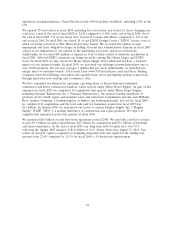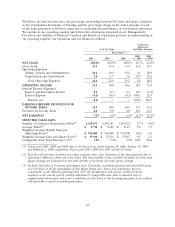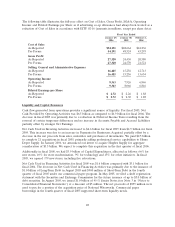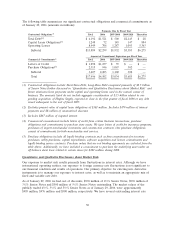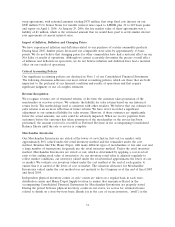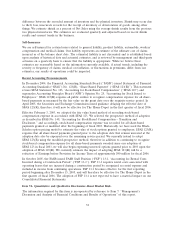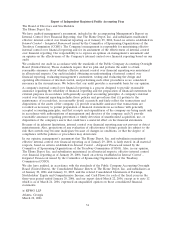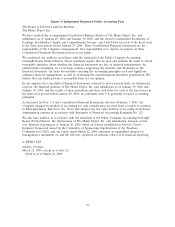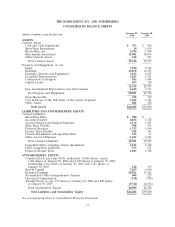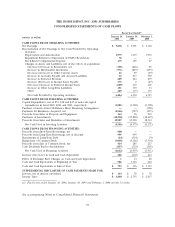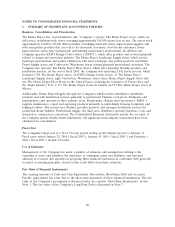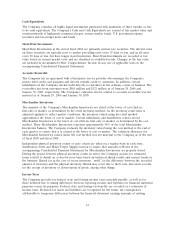Home Depot 2005 Annual Report Download - page 43
Download and view the complete annual report
Please find page 43 of the 2005 Home Depot annual report below. You can navigate through the pages in the report by either clicking on the pages listed below, or by using the keyword search tool below to find specific information within the annual report.
swap agreements, with notional amounts totaling $475 million, that swap fixed rate interest on our
$500 million 53⁄8% Senior Notes for variable interest rates equal to LIBOR plus 30 to 245 basis points
and expire on April 1, 2006. At January 29, 2006, the fair market value of these agreements was a
liability of $1 million, which is the estimated amount that we would have paid to settle similar interest
rate agreements at current interest rates.
Impact of Inflation, Deflation and Changing Prices
We have experienced inflation and deflation related to our purchase of certain commodity products.
During fiscal 2005, lumber prices decreased our comparable store sales by approximately 13 basis
points. We do not believe that changing prices for other commodities have had a material effect on our
Net Sales or results of operations. Although we cannot accurately determine the precise overall effect
of inflation and deflation on operations, we do not believe inflation and deflation have had a material
effect on our results of operations.
Critical Accounting Policies
Our significant accounting policies are disclosed in Note 1 of our Consolidated Financial Statements.
The following discussion addresses our most critical accounting policies, which are those that are both
important to the portrayal of our financial condition and results of operations and that require
significant judgment or use of complex estimates.
Revenue Recognition
We recognize revenue, net of estimated returns, at the time the customer takes possession of the
merchandise or receives services. We estimate the liability for sales returns based on our historical
return levels. The methodology used is consistent with other retailers. We believe that our estimate for
sales returns is an accurate reflection of future returns. We have never recorded a significant
adjustment to our estimated liability for sales returns. However, if these estimates are significantly
below the actual amounts, our sales could be adversely impacted. When we receive payment from
customers before the customer has taken possession of the merchandise or the service has been
performed, the amount received is recorded as Deferred Revenue in the accompanying Consolidated
Balance Sheets until the sale or service is complete.
Merchandise Inventories
Our Merchandise Inventories are stated at the lower of cost (first-in, first-out) or market, with
approximately 86% valued under the retail inventory method and the remainder under the cost
method. Retailers like The Home Depot, with many different types of merchandise at low unit cost and
a large number of transactions, frequently use the retail inventory method. Under the retail inventory
method, Merchandise Inventories are stated at cost, which is determined by applying a cost-to-retail
ratio to the ending retail value of inventories. As our inventory retail value is adjusted regularly to
reflect market conditions, our inventory valued under the retail method approximates the lower of cost
or market. We evaluate our inventory valued under the cost method at the end of each quarter to
ensure that it is carried at the lower of cost or market. The valuation allowance for Merchandise
Inventories valued under the cost method was not material to the Company as of the end of fiscal 2005
and fiscal 2004.
Independent physical inventory counts or cycle counts are taken on a regular basis in each store,
distribution center and Home Depot Supply location to ensure that amounts reflected in the
accompanying Consolidated Financial Statements for Merchandise Inventories are properly stated.
During the period between physical inventory counts in our stores, we accrue for estimated losses
related to shrink on a store-by-store basis. Shrink (or in the case of excess inventory, ‘‘swell’’) is the
31


